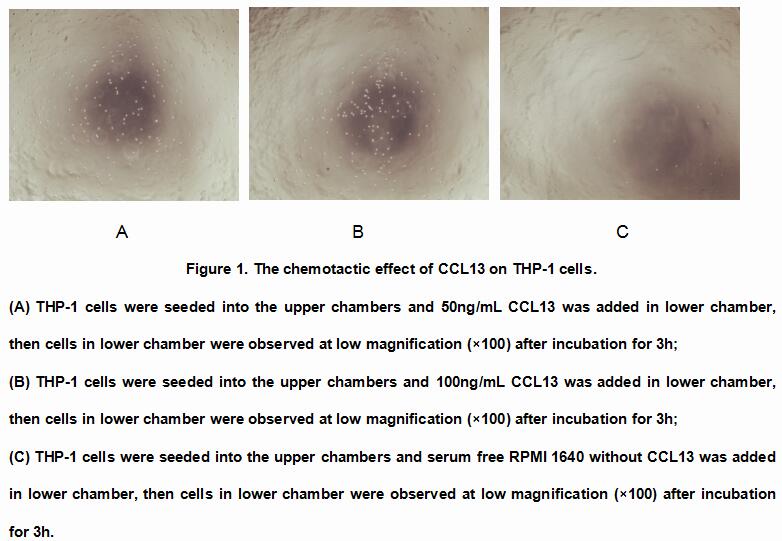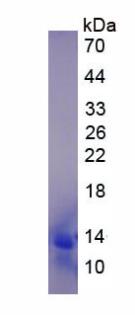Active Monocyte Chemotactic Protein 4 (MCP4)
CCL13; SCYA13; NCC1; SCYL1; CKb10; Chemokine C-C-Motif Ligand 13; Small Inducible Cytokine Subfamily A(Cys-Cys)Member 13; CK-beta-10; Monocyte chemoattractant 4
- Product No.APA216Hu51
- Organism SpeciesHomo sapiens (Human) Same name, Different species.
- Buffer Formulation20mM Tris, 150mM NaCl, pH8.0, containing 1mM EDTA, 1mM DTT, 0.01% SKL, 5% Trehalose and Proclin300.
- Traits Freeze-dried powder
- Purity> 95%
- Isoelectric Point10.0
- ApplicationsCell culture; Activity Assays; In vivo assays.
- DownloadInstruction Manual
- UOM 10µg50µg 200µg 1mg 5mg
- FOB
US$ 139
US$ 348
US$ 696
US$ 2088
US$ 5220
For more details, please contact local distributors!
ACTIVITY TEST


CCL13 (C-C motif chemokine 13) is a chemotactic factor that attracts monocytes, lymphocytes, basophils and eosinophils, which belongs to the CC chemokine subfamily. It has been reported that CCL13 can induce chemotactic migration of THP-1 cells. Therefore, chemotaxis assay used 24-well microchemotaxis system was undertaken to detect the chemotactic effect of CCL13 on the human monocytic cell line THP-1. Briefly, THP-1 cells were seeded into the upper chambers (100µL cell suspension, 106 cells/mL in RPMI 1640 with 0.5% FBS) and CCL13 (50ng/mL and 100ng/mL diluted separately in serum free RPMI 1640) was added in lower chamber with a polycarbonate filter (8µm pore size) used to separate the two compartments. After incubation at 37oC with 5% CO2 for 3h, the filter was removed, then cells in low chamber were observed by inverted microscope at low magnification (×100) and the number of migrated cells were counted at high magnification (×400) randomly (five fields for each filter).
Result: CCL13 is able to induce migration of THP-1 cells. The migrated THP-1 cells in low chamber at low magnification (×100) were shown in Figure 1. Five fields of each chamber were randomly chosen to count the migrated cells at high magnification (×400) and the statistical data was shown in Figure 2.
USAGE
Reconstitute in 20mM Tris, 150mM NaCl (PH8.0) to a concentration of 0.1-1.0 mg/mL. Do not vortex.
STORAGE
Avoid repeated freeze/thaw cycles. Store at 2-8°C for one month. Aliquot and store at -80°C for 12 months.
STABILITY
The thermal stability is described by the loss rate. The loss rate was determined by accelerated thermal degradation test, that is, incubate the protein at 37°C for 48h, and no obvious degradation and precipitation were observed. The loss rate is less than 5% within the expiration date under appropriate storage condition.
GIVEAWAYS
INCREMENT SERVICES
-
 BCA Protein Quantification Kit
BCA Protein Quantification Kit
-
 Molecular Mass Marker for Protein
Molecular Mass Marker for Protein
-
 Monoclonal Antibody Customized Service
Monoclonal Antibody Customized Service
-
 Polyclonal Antibody Customized Service
Polyclonal Antibody Customized Service
-
 Protein Activity Test Experiment Service
Protein Activity Test Experiment Service
-
 Electrophoretic Mobility Shift Assay (EMSA) Experiment Service
Electrophoretic Mobility Shift Assay (EMSA) Experiment Service
-
 Buffer
Buffer
-
 Lentivirus Packaging Experiment Service
Lentivirus Packaging Experiment Service
-
 Adenovirus Packaging Experiment Service
Adenovirus Packaging Experiment Service
-
 Real Time PCR Experimental Service
Real Time PCR Experimental Service
-
 Spike RBD Protein (S-RBD)
Spike RBD Protein (S-RBD)
-
 Protein G
Protein G
-
 Protein A
Protein A









